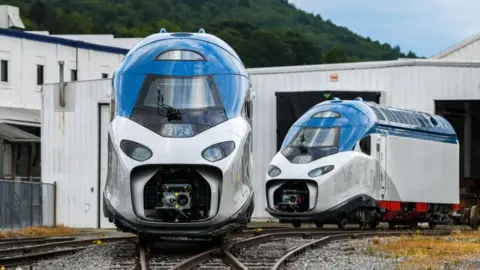### The Emergence of High-Speed Rail in the U.S.: A New Era?
The United States, a nation comprising approximately 340 million residents, boasts an impressive infrastructure of 71 interstate highways and over 5,000 public airports. However, it conspicuously lacks a high-speed rail (HSR) network, a stark contrast to nations like China, Japan, and various European countries, where speedy train systems are prevalent. Recent developments, including the commencement of two significant high-speed rail projects—San Francisco to Los Angeles and Las Vegas to Los Angeles—ignite hope among advocates that the U.S. might finally leap towards modern transportation advancement.
Rick Harnish, the executive director of the High-Speed Rail Alliance, expressed cautious optimism about the initiation of these two projects. He highlighted the enormous challenge posed by the mountainous terrain of California on the San Francisco-Los Angeles route. In contrast, the Las Vegas to Los Angeles line will be laid on relatively flat land, simplifying construction significantly. Further ambitions include developing an HSR corridor stretching from Portland, Oregon, to Seattle, Washington, and extending into Canada with plans for a line between Dallas and Houston.
Despite these promising developments, significant challenges remain. Harnish noted that the planning processes for the Portland-Seattle route are languishing, hindered by a lack of funding and political will, particularly following the cancellation of a substantial federal grant intended for the Texas line during the Trump administration.
### The Global Comparison: How HSR Measures Up
The current state of high-speed rail in the U.S. starkly contrasts with the rapid advancements seen globally. According to reports, China’s high-speed rail network is projected to exceed an astonishing 50,000 kilometers (31,000 miles) this year, while the European Union hosts around 8,556 kilometers of HSR lines—Spain alone accounting for 3,190 kilometers. In the UK, High Speed 1 remains the only operational HSR line, with ongoing construction of High Speed 2 amid notable funding controversies.
World railway expert organizations, such as the International Union of Railways, define high-speed trains as those capable of traveling over 250 kilometers per hour (155 miles per hour). The hesitance to embrace HSR in the U.S. is indicative of deep-rooted cultural preferences, as articulated by rail journalist Will Doig, who emphasized America’s historical dependence on automobiles. Many citizens remain indifferent to HSR options appearing in their regions, often viewing such projects with skepticism.
### Governance and Investment: The Crux of Progress
The political landscape remains another obstacle. Recently, Amtrak, the state-sponsored passenger train service, experienced leadership upheaval with the resignation of CEO Stephen Gardner, amid various pressures—dubbed a significant setback for rail ambitions. Currently, Amtrak does not operate HSR trains, although it is anticipated to introduce new 160 mph NextGen Acela trains along its Northeast Corridor service this year. However, logistical limitations mean that only a mere stretch of 50 miles of the 457-mile route currently facilitates speeds over 150 mph.
The projects under construction, the California High-Speed Rail from San Francisco to Los Angeles, and Brightline West from Los Angeles to Las Vegas, fall outside Amtrak’s purview. The completion of the former is slated for 2033, while Brightline West is expected to serve passengers by 2028. However, the absence of operational HSR trains within Amtrak’s purview raises questions about the federal government’s vision for the future of rail transport in the U.S.
### A Broader Perspective: Global Developments in HSR
Globally, 23 nations have successfully implemented HSR systems, as per Harnish’s findings. The operational complexities of HSR, such as eliminating level crossings and maintaining straight tracks within sealed corridors, pose unique challenges. Looking towards China, the nation continuously enhances its own extensive network, planning to reach approximately 60,000 kilometers by 2030—information underscored by the increased economic benefits of HSR connectivity.
Conversely, increasing investment in HSR systems across Europe showcases a culturally intrinsic commitment to public infrastructure, highlighting the contrast with the U.S. road dependency. The think tank 21st Europe envisions further extending HSR connections throughout the continent, pressing for infrastructural evolution that reconsiders transit ideals.
### Challenges Ahead: Cultural Shifts and Political Will
Kaave Pour of 21st Europe has emphatically echoed the need for a cultural mindset transition in the U.S. towards public transport, urging reflection on desired futuristic transit paradigms. Moreover, federal involvement is indispensable for the realization of successful HSR initiatives, yet current political sentiments suggest a waning interest in public spending directed at rail enhancement. The recent rejection of federal funds for the Houston-Dallas high-speed line encapsulates this sentiment.
In summary, while recent strides toward establishing high-speed rail networks in the U.S. evoke optimism, substantial hurdles remain. Political governance,



